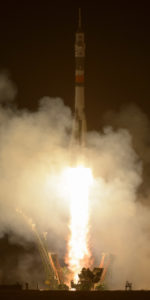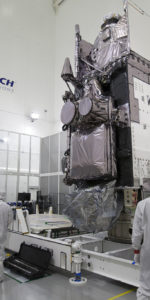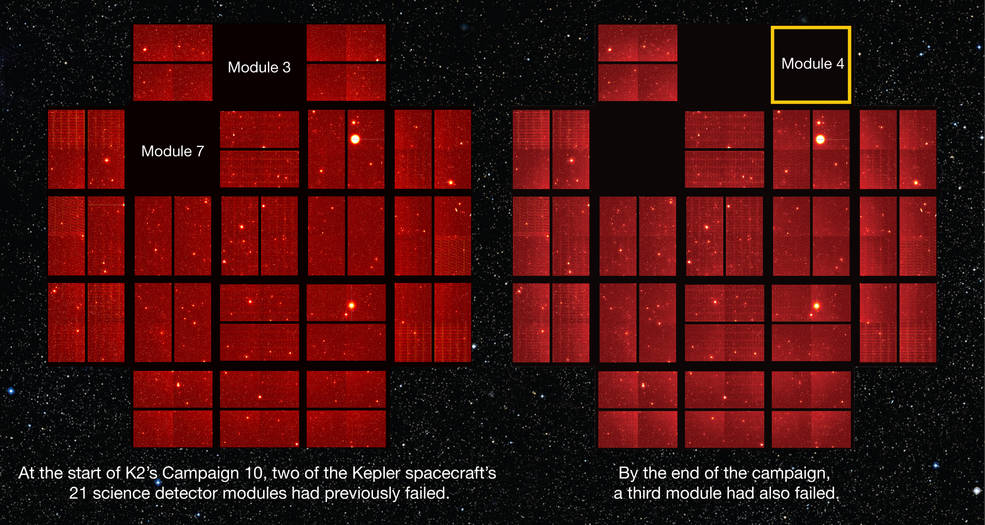
The Kepler K2 mission has now resumed after a delay of three days, NASA has reported. The Kepler Space Telescope is currently in Campaign 11, during which it is observing a total of 14,250 new targets, including the Galactic Center as well as two of Saturn’s moons, Enceladus and Titan.
This current campaign phase began on Sept. 24 and will continue until Dec. 7. It was interrupted for three days, from Oct. 18-20, due to an imbalance caused by data being broadcast by a different antenna on the other side of the spacecraft. Kepler is very delicately balanced in its orbit and can turn slightly when switching from one antenna to another. Such precise balance is essential for Kepler to be able to remain focused on its distant targets.
During the previous 10th campaign, science detector Module 4 failed, causing Kepler’s onboard camera, the photometer, to be turned off. After investigation, it is thought that it was the result of a random part failure, which caused a high electric current in the circuitry, which in turn blew the protection fuse, disabling the detector. Other detectors were not affected, however, and as part of the fault protection response the photometer was powered off. Eighteen of the 21 science detector modules, meanwhile, are still fully operational. Previously, Module 7 failed in January 2014 and Module 3 stopped working in January 2010.
The data from Campaign 10 is has been downlinked and is being processed for release in a public archive later this month.
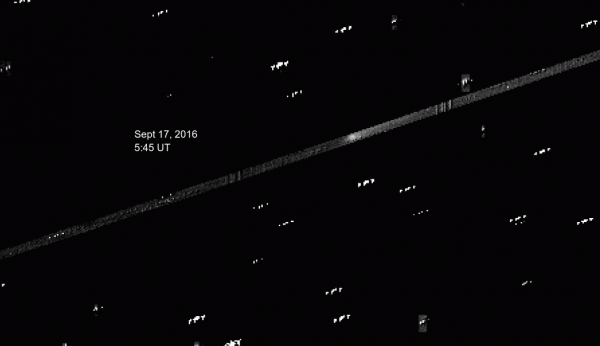
So what else has Kepler been up to?
Last September, the space telescope observed comet 67P/Churyumov–Gerasimenko, providing a wide-angle view of the core and tail of the comet. Ground-based telescopes were not able to observe the comet at the time, since the comet’s orbit placed it too high in the sky during daylight hours. Kepler observed the comet from Sept. 7-20, taking an image of the comet every 30 minutes. These observations complement those from the Rosetta spacecraft, which concluded its mission on Sept. 30.
Last month, Kepler, along with the Swift mission, observed a group of rapidly spinning stars which produce X-rays 100 times more powerful than any seen from the Sun. The stars have been “squashed” into pumpkin-like shapes because they are spinning so fast.
“These 18 stars rotate in just a few days on average, while the Sun takes nearly a month,” said Steve Howell, a senior research scientist at NASA’s Ames Research Center in Moffett Field, Calif., and leader of the research team. “The rapid rotation amplifies the same kind of activity we see on the Sun, such as sunspots and solar flares, and essentially sends it into overdrive.”
The unusual stars are thought to result when two close binary stars merge together. They were discovered during an X-ray survey of the original Kepler field of view, a patch of the sky which includes parts of the constellations Cygnus and Lyra.
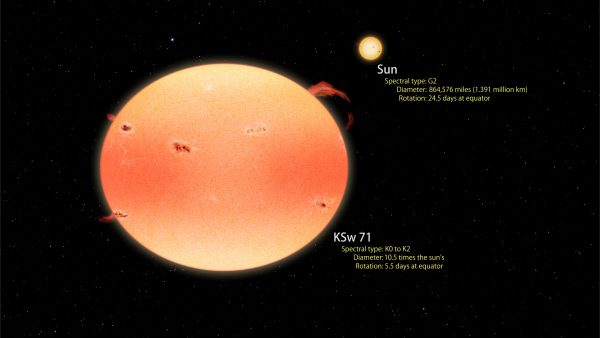
One of the stars, a K-type orange giant called KSw 71, is more than 10 times the size of the Sun, rotates in just 5.5 days, and produces X-ray emissions which are 4,000 times greater than the Sun at solar maximum.
“A side benefit of the Kepler mission is that its initial field of view is now one of the best-studied parts of the sky,” said team member Padi Boyd, a researcher at NASA’s Goddard Space Flight Center in Greenbelt, Md., who designed the Swift survey. For example, the entire area was observed in infrared light by NASA’s Wide-field Infrared Survey Explorer, and NASA’s Galaxy Evolution Explorer observed many parts of it in the ultraviolet. “Our group was looking for variable X-ray sources with optical counterparts seen by Kepler, especially active galaxies, where a central black hole drives the emissions,” she said.
Astronomers conducted the Kepler–Swift Active Galaxies and Stars Survey (KSwAGS), using the X-ray and ultraviolet/optical telescopes aboard the Swift spacecraft. They imaged about six square degrees, or 12 times the apparent size of a full Moon, in the Kepler field.
“With KSwAGS we found 93 new X-ray sources, about evenly split between active galaxies and various types of X-ray stars,” said team member Krista Lynne Smith, a graduate student at the University of Maryland, College Park, who led the analysis of Swift data. “Many of these sources have never been observed before in X-rays or ultraviolet light.”
These findings were published in the Nov. 1 edition of the Astrophysical Journal and are available online.
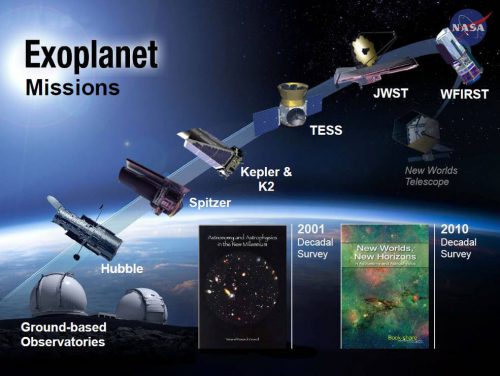
Kepler’s primary mission lasted from May 2009 to May 2013, and it measured the brightness of more than 150,000 stars in the original Kepler field of view. That mission discovered more than 2,300 confirmed exoplanets and nearly 5,000 candidates. The extended mission, called K2, continues similar observations, but in areas of the sky located along the ecliptic, the plane of Earth’s orbit around the Sun. The K2 mission was developed after two of the reaction wheels on the spacecraft failed, which are used to help stabilize the spacecraft in space. Kepler is hobbled now, but still able to do an incredible amount of science.
According to Paul Hertz, Astrophysics Division director at NASA Headquarters: “Before the Kepler space telescope launched, we did not know whether exoplanets were rare or common in the galaxy. Thanks to Kepler and the research community, we now know there could be more planets than stars. This knowledge informs the future missions that are needed to take us ever-closer to finding out whether we are alone in the universe.”
By extrapolating the data from Kepler to the whole galaxy, astronomers now estimate that there are billions of planets in our galaxy alone. There may even be more planets than stars.
“Planet candidates can be thought of like bread crumbs,” said Timothy Morton, an associate research scholar at Princeton University. “If you drop a few large crumbs on the floor, you can pick them up one by one. But, if you spill a whole bag of tiny crumbs, you’re going to need a broom. This statistical analysis is our broom.”
One of the key questions of course is how many of those planets may be habitable. So far, Kepler data indicates that smaller planets—smaller than Neptune, “super-Earths,” and worlds smaller than Earth—are the most common.
“They say not to count our chickens before they’re hatched, but that’s exactly what these results allow us to do based on probabilities that each egg (candidate) will hatch into a chick (bona fide planet),” said Natalie Batalha, a Kepler mission scientist at NASA’s Ames Research Center. “This work will help Kepler reach its full potential by yielding a deeper understanding of the number of stars that harbor potentially habitable, Earth-size planets – a number that’s needed to design future missions to search for habitable environments and living worlds.”
After Kepler has finished its mission, new space telescopes such as TESS, JWST, and WFIRST will continue the search for more exoplanets in other regions of the galaxy, as well as provide more data on some of the ones already discovered, including mass and atmospheric conditions. Astronomers will actually be able to analyze the atmospheres of some of these worlds, in particular smaller “super-Earths,” in the search for possible biomarkers—gases which could be possible evidence for life. The Kepler mission has been incredibly exciting, and it’s not over yet.
More information about the Kepler mission is available here.
Want to keep up-to-date with all things space? Be sure to “Like” AmericaSpace on Facebook and follow us on Twitter: @AmericaSpace




